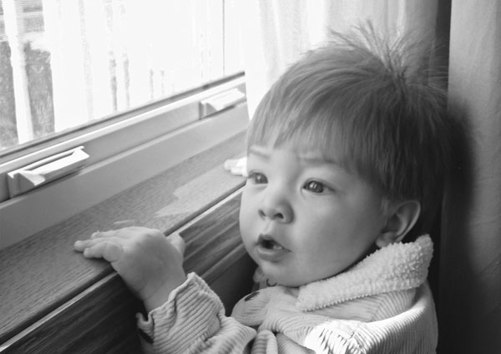The No-Cry Separation Anxiety Solution: Gentle Ways to Make Good-bye Easy from Six Months to Six Years (7 page)
Authors: Elizabeth Pantley
Tags: #0071596909

those problems that
you
feel are problems. Every family views separa-
tion anxiety issues differently. Just because there is a chapter about
how to help your baby accept a babysitter, it doesn’t mean you have
to hire one. If you are happy taking your baby along with you on
your night out—then go right ahead and do that. Just because there
is a chapter about how to help your child adjust to daycare, it doesn’t
mean that every child should attend daycare; it means that
if
your
child is struggling in this area and you’d like to help him adjust and
become happy in the situation,
then
I will provide you with ideas to
help you make that change. On the other hand, if you decide that
it’s best to pass on daycare for now and simply keep your child at
home with you, then that may be
your
best solution. Many children
bypass the daycare experience—and some even bypass the preschool
experience—yet go on to be perfectly well-adjusted and happy kids
with lots of friends once they begin kindergarten. I know because I
had one of those children!

18 The No-Cry Separation Anxiety Solution
Braedon, six months old
As part of the process, consider why you feel the issue needs to
be solved. Is this truly something that must be addressed for your
child’s emotional growth? Is this situation the absolute best one for
everyone in the family? Are you considering changes because of your
own memories of childhood, input from outsiders, or worries about
potential problems, or is this something that is truly affecting your
child and must be addressed now?
There’s a fl ip side to outside infl uences as well. It comprises the
other half of the population, who feels you are making the wrong
decision when you address your child’s anxiety by doing what’s neces-
sary to move her forward. Once you have decided it’s time to let your
child take a separation step, whether it’s going to camp, a playdate,
or daycare, you should never accept guilt-infl icting comments that
encouraging your child’s separation is a bad thing or that you are
being selfi sh or neglectful! It is a wonderful thing to help your child
become more independent. And it’s great to be able to go on a date
night, take a class, go to work, have lunch with friends, or use the
bathroom all by yourself, and leave your child in the care of another
All About Separation Anxiety in Early Childhood
19
loving, competent adult. Your child can blossom while in the care of
someone other than you. There is an added benefi t for your child—
the value of learning how to interact with many different kinds of
people outside your immediate family.
There are no cookie-cutter solutions to any parenting problem,
including separation anxiety. I will provide an assortment of ideas for
you to choose from for each situation. Pick one, pick two, or combine
a variety of ideas to create a personalized plan for your child. Then
adjust and modify your plan as you go until you fi nd the right solu-
tion. That’s how the process of raising children works best.
With this important concept in mind, let’s start with a crucial
principle that I urge you to keep as a guiding light throughout the
rest of this book—and for that matter, the rest of your life. This con-
cept can be applied to almost any parenting decision you’ll face from
now through grandchildren, and even your
great-
grandchildren.
The No-Cry Process for Peaceful Problem Solving
There are no absolute rules about raising children and no guar-
antees for any parenting techniques. Raise your children as
you choose to raise them in ways that are right for you. Within
the range of your comfort zone, modify your approach for
each of your children based on their needs, personality, and
temperament.
Address only those problems that you believe are true
problems, and don’t create or imagine problems because some-
one else thinks you have them, no matter if that person is family,
friend, or expert.
Keep your problems in perspective and take ample time to
plot the best course of action. Solve your problems by analyzing
possible solutions and choosing those that are right for you and
your family. Know that there is rarely one right answer, and often
you must take multiple routes to get to the best destination.
Read, listen, and learn constantly, but always sift what you
learn through the strainer of your own personal beliefs and par-
enting philosophy.
20 The No-Cry Separation Anxiety Solution
Mother-Speak
“Luke was a mega-attached baby. I couldn’t leave him with a
babysitter, couldn’t leave his side at the park, or couldn’t leave
the room without him melting down. Heck, I couldn’t even
use the bathroom without having him by my side! People told
me I was being oversensitive to his needs and I should let
him grow up—which seemed ridiculous to me. Since when is
it necessary for a baby to be in a rush to grow up? Especially
when so much of what I’ve done in his life has been to create
a strong bond between us. That bond is worth its weight in
gold to me.
“Yet I still found I wanted to have a dinner out with adults
or go for a jog without pushing the stroller. I didn’t know how
to achieve this without Luke crying. So I fi gured I’d go to the
No-Cry expert for advice, and I’m so glad I did!
“Since I’ve been working on the ideas you gave me, I’ve
changed my approach. I’ve been patient and responsive to his
cues, but I’ve also started giving him space when the opportu-
nity presents itself. We’ve played the separation games. I have
taken things step-by-step, with lots of reassurance. I carefully
present him with new situations, explain them beforehand,
and then ease him into them gradually. I recently gave Luke
his very own Magic Bracelet when he went overnight to his
grandmother’s house, and it was truly magic. They had a great
time—with no crying!
“I have to tell you that Luke is so secure now that he’s count-
ing off the days until preschool starts on the wall calendar,
and he happily goes off to the health club daycare—and any-
where else, for that matter, anytime he’s invited. He’s become
quite a social butterfl y. Now I’m the one having separation
anxiety!”
—Gloria, mother of four-year-old Luke

2
No-Cry Solutions for
Babies and Toddlers
From the time that babies become aware of the world around
them, they begin to form important relationships with the people
in their lives. They quickly learn that certain people are vital to their
happiness and survival. Babies and toddlers don’t have the ability to
understand how the world works, so they don’t know what makes
these people appear or disappear, and when they are out of sight, the
little ones have no way of knowing if their beloved people are gone
forever. Babies and toddlers crave the nearness of those they love, so
to protect themselves from potential loss, they use the only methods
they have available to them to express their feelings: they cry and
they cling.
Try to embrace separation anxiety as a positive sign. It’s perfectly
okay—even wonderful—for your child to be so attached to you and
for her to desire your constant companionship. It’s evidence that the
bond you’ve worked so hard to create is holding. So politely ignore
those who tell you otherwise.
Over time, your little one will learn that when the two of you
are separated everything is just fi ne and other people are capable of
meeting her needs. She’ll also learn through experience that you
always return eventually. It will take time, however, for your child to
mature enough to reach this point. Until then, to help her learn to
understand, accept, and deal with separation, try some of the follow-
ing ideas.
21

22 The No-Cry Separation Anxiety Solution
Alex, nine months old
Play Peek-a-Boo with Objects
This time-honored game is a great way to teach your baby an impor-
tant concept that will allow him to begin to understand the founda-
tion of separation: things exist even if he can’t see them, and when
they go, they come back. This will be helpful when it’s
you
that is
gone and cannot be seen. Take an opportunity during playtime to
hide toys under blankets or containers and then pull them back out
again with a fl ourish. When you put something under a blanket, you
can sometimes let your baby feel it from the top to show that the
object is still there. Or put something in a jar and rattle it around,
then slowly pull it out little by little. Let your baby have a turn with
the toy hiding too, and then you can fi nd it with a joyful hurrah.
A great variation on this game is to use a toy house and toy people
and show them going in and out and around. Get creative here and
show them driving off in a car, going to the offi ce or grocery store or
wherever you go when you leave the house. Always have a pleasant
good-bye and a happy moment when they arrive back home. Play the
game often for the best learning effect.
No-Cry Solutions for Babies and Toddlers
23
Play Peek-a-Boo with People
Parents seem to play this game instinctually, and it’s more than just
for fun, it’s an important lesson for your baby. One step beyond peek-
a-boo with toys, this game actually demonstrates that people still
exist even when you can’t see them—and that they do return and it’s
fun when they come back.
There are many ways to play. You can hide your face behind your
hands or a blanket, or even behind your baby’s legs during diaper
changes. Stay hidden for a few seconds, and then you might ask,
“Where’s Mommy?” Pause while your baby processes the question
and then pop out and cheerfully announce, “Peek-a-boo! Here I am!”
Over time, hide more of your face and then hide for longer periods of
time. You can also use an object to cover your baby’s face (“Where’s
Baby?”) and then let
him
be the one to pop out.
Father-Speak
“I discovered that the games we have been playing with Mad-
die are working. I went out to the store for an hour, and when
I came back, she bounced up, threw up her arms, and yelled,
